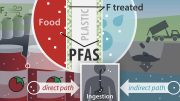
UC San Francisco researchers reveal that the chemical industry, particularly DuPont and 3M, suppressed information about the health risks of PFAS (“forever chemicals”) similar to tobacco industry tactics. The study highlights a delay in public and regulatory awareness about PFAS toxicity despite industry knowledge of the risks.
Widely used in clothing, household products and food, they resist breaking down in the environment.
The chemical industry took a page out of the tobacco playbook when they discovered and suppressed their knowledge of health harms caused by exposure to PFAS (per- and polyfluoroalkyl substances), according to an analysis of previously secret industry documents by UC San Francisco (UCSF) researchers.
A new paper published on June 1, 2023, in Annals of Global Health, examines documents from DuPont and 3M, the largest manufacturers of PFAS, and analyzes the tactics industry used to delay public awareness of PFAS toxicity and, in turn, delay regulations governing their use. PFAS are widely used chemicals in clothing, household goods, and food products, and are highly resistant to breaking down, giving them the name “forever chemicals.” They are now ubiquitous in people and the environment.
“These documents reveal clear evidence that the chemical industry knew about the dangers of PFAS and failed to let the public, regulators, and even their own employees know the risks,” said Tracey J. Woodruff, PhD, professor and director of the UCSF Program on Reproductive Health and the Environment (PRHE), a former senior scientist and policy advisor at the Environmental Protection Agency (EPA), and senior author of the paper.
This is the first time these PFAS industry documents have been analyzed by scientists using methods designed to expose tobacco industry tactics.
Adverse Effects Had Been Known for Decades
The secret industry documents were discovered in a lawsuit filed by attorney Robert Bilott, who was the first to successfully sue DuPont for PFAS contamination and whose story was featured in the film, “Dark Waters.” Bilott gave the documents, which span 45 years from 1961 to 2006, to producers of the documentary, “The Devil We Know,” who donated them to the UCSF Chemical Industry Documents Library.
“Having access to these documents allows us to see what the manufacturers knew and when, but also how polluting industries keep critical public health information private,” said first author Nadia Gaber, MD, PhD, who led the research as a PRHE fellow and is now an emergency medicine resident. “This research is important to inform policy and move us towards a precautionary rather than reactionary principle of chemical regulation.”
Little was publicly known about the toxicity of PFAS for the first 50 years of their use, the authors stated in the paper, The Devil They Knew: Chemical Documents Analysis of Industry Influence on PFAS Science, despite the fact that “industry had multiple studies showing adverse health effects at least 21 years before they were reported in public findings.”
The paper states that, “DuPont had evidence of PFAS toxicity from internal animal and occupational studies that they did not publish in the scientific literature and failed to report their findings to EPA as required under TSCA. These documents were all marked as ‘confidential,’ and in some cases, industry executives are explicit that they ‘wanted this memo destroyed.’”
Suppressing Information to Protect a Product
The paper documents a timeline of what industry knew versus public knowledge and analyzes strategies the chemical industry used to suppress information or protect their harmful products. Examples include:
- As early as 1961, according to a company report, Teflon’s Chief of Toxicology discovered that Teflon materials had “the ability to increase the size of the liver of rats at low doses,” and advised that the chemicals “be handled ‘with extreme care’ and that ‘contact with the skin should be strictly avoided.’”
- According to a 1970 internal memo, DuPont-funded Haskell Laboratory found C8 (one of thousands of PFAS) to be “highly toxic when inhaled and moderately toxic when ingested.” And in a 1979 private report for DuPont, Haskell labs found that dogs who were exposed to a single dose of PFOA “died two days after ingestion.”
- In 1980, DuPont and 3M learned that two of eight pregnant employees who had worked in C8 manufacturing gave birth to children with birth defects. The company did not publish the discovery or tell employees about it, and the following year an internal memo stated, “We know of no evidence of birth defects caused by C-8 at DuPont.”
Despite these and more examples, DuPont reassured its employees in 1980 that C8, “has a lower toxicity, like table salt.” Referring to reports of PFAS groundwater contamination near one of DuPont’s manufacturing plants, a 1991 press release claimed, “C-8 has no known toxic or ill health effects in humans at concentration levels detected.”
As media attention to PFAS contamination increased following lawsuits in 1998 and 2002, DuPont emailed the EPA asking, “We need EPA to quickly (like first thing tomorrow) say the following: That consumer products sold under the Teflon brand are safe and to date there are no human health effects known to be caused by PFOA.”
In 2004, the EPA fined DuPont for not disclosing their findings on PFOA. The $16.45 million settlement was the largest civil penalty obtained under U.S. environmental statutes at the time. But it was still just a small fraction of DuPont’s $1 billion annual revenues from PFOA and C8 in 2005.
“As many countries pursue legal and legislative action to curb PFAS production, we hope they are aided by the timeline of evidence presented in this paper,” said Woodruff. “This timeline reveals serious failures in the way the U.S. currently regulates harmful chemicals.”
Reference: “The Devil they Knew: Chemical Documents Analysis of Industry Influence on PFAS Science” by Nadia Gaber, Lisa Bero and Tracey J. Woodruff, 1 June 2023, Annals of Global Health.
DOI: 10.5334/aogh.4013








Recently PFAS are also revealed to be lowering male fertility by lowering testosterone [1] level globally. But still PFAS are everywhere, especially on non-stick pans where foods are cooked for men.
1. Testosterone is a hormone which is considered an enemy by ho*osexu*ls and hardline feminists.
That’s all well and fine but without punishment they and the next company will only work harder to hide any evidence. If the government really cares about us they would fi e these companies into bankruptcy and whoever takes over the chemical supply would be strictly regulated. Because it’s obvious that corporations don’t care about anything except their bottomline
https://www.youtube.com/watch?v=BXlYuaycRbU
My brother in-law made Teflon rolls, he died several yrs later riddled with cancer top to bottom, he was just 65 yrs old. Ronnie Brahan, his wife received nothing.Saint-Gobain in Hoosick Falls, NY. They contaminated the towns water system & swage system & the Hoosick River that flows into the Hudson River. I’ve handled many toxic barrels of teflon for Oak Mitsui another toxic business who gave me lung disease running an Arsenic treater for making copper foil for printer circuitry, without any safety equipment boiling vats@ 212 degrees, evaporating in your face. Coughed up raw blood, nose bleeds that wouldn’t stop. server chest pains that would double me over. 9 people died working there in just 2 yrs. They polluted the land, air, Hoosick River & everyone who worked there. They finally shut down & moved to Columbia, SC. closer to the Ocean to hide & dump their toxins on another river. All of these vile wipes are killing the entire planet as they all laugh to the bank, Just more vile maggots in business. Just pay off politician’s to make it all legal & OK to kill people who need a job.
That which gets rewarded gets repeated, so with no consequential legal action there is no reason to expect any change. Having failed to openly acknowledge the potentially dangerous outcomes of a chemical is a clear indication of a breach of implicit trust between the manufacturers of this chemical and the public. In other words, DuPont and 3M appear to be complicit in a carefully constructed conscious deceit and as such cannot be trusted or respected. The public should recognize this fact and acknowledge that the tobacco and auto industries have also ridden rough shot over public health concerns over the years. Obviously when a corporations does this it should be put under close observation for a period of time and the chief executives should be held legally responsible for their actions or failures to act. When this doesn’t happen the concepts of democracy and capitalism suffer ongoing defeats. One logical question that occurs is will the big five tech companies be playing the same sleight of hand games with AI and ML? Can they be trusted any more than the big blue chip automotive, tobacco, and chemical companies who have already shown their colours. I think not, and fear the consequences.